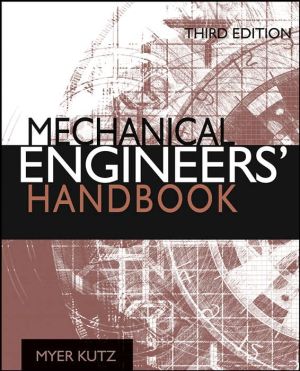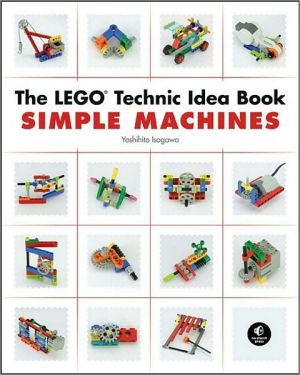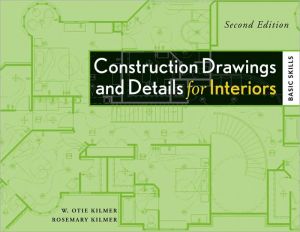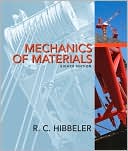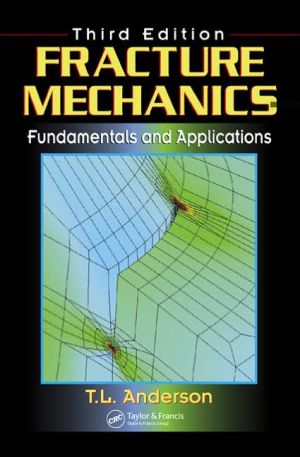Mechanical Engineers' Handbook
Mechanical Engineers' Handbook, Third Edition, Four Volume Set provides a single source for all critical information needed by mechanical engineers in the diverse industries and job functions they find themselves. No single engineer can be a specialist in all areas that they are called on to work and the handbook provides a quick guide to specialized areas so that the engineer can know the basics and where to go for further reading.
Search in google:
Mechanical Engineers' Handbook, Third Edition, provides a single source for all critical information needed by mechanical engineers in the diverse industries and job functions they find themselves. No single engineer can be a specialist in all areas that they are called on to work and the handbook provides a quick guide to specialized areas so that the engineer can know the basics and where to go for further reading. Book 1: Materials and Mechanical Design Book 2: Instrumentation, Systems, Controls, and MEMS Book 3: Manufacturing and Management Book 4: Energy and Power
Mechanical Engineers' Handbook, Four Volume Set\ \ By Myer Kutz \ John Wiley & Sons\ ISBN: 0-471-44990-3 \ \ \ Chapter One\ CARBON AND ALLOY STEELS\ Bruce L. Bramfitt International Steel Group, Inc. Research Laboratories Bethlehem, Pennsylvania\ 1 INTRODUCTION 3\ 2 STEEL MANUFACTURE 4\ 3 DEVELOPMENT OF STEEL PROPERTIES 5\ 4 ROLE OF ALLOYING ELEMENTS IN STEEL 18\ 5 HEAT TREATMENT OF STEEL 25\ 6 CLASSIFICATION AND SPECIFICATIONS OF STEELS 26 6.1 Carbon Steels 27 6.2 Alloy Steels 29\ 7 SUMMARY 37\ BIBLIOGRAPHY 37\ 1 INTRODUCTION\ Steel is the most common and widely used metallic material in today's society. It can be cast or wrought into numerous forms and can be produced with tensile strengths exceeding 5 GPa. A prime example of the versatility of steel is in the automobile where it is the material of choice and accounts for over 60% of the weight of the vehicle. Steel is highly formable as seen in the contours of the automobile outerbody. Steel is strong and is used in the body frame, motor brackets, driveshaft, and door impact beams of the vehicle. Steel is corrosion resistant when coated with the various zinc-based coatings available today. Steel is dent resistant when compared with other materials and provides exceptional energy absorption in a vehicle collision. Steel is recycled and easily separated from other materials by a magnet. Steel is inexpensive compared with other competing materials such as aluminum and various polymeric materials.\ In the past, steel has been described as an alloy of iron and carbon. Today, this description is no longer applicable since in some very important steels, e.g., interstitial-free (IF) steels and type 409 ferritic stainless steels, carbon is considered an impurity and is present in quantities of only a few parts per million. By definition, steel must be at least 50% iron and must contain one or more alloying elements. These elements generally include carbon, manganese, silicon, nickel, chromium, molybdenum, vanadium, titanium, niobium, and aluminum. Each chemical element has a specific role to play in the steelmaking process or in achieving particular properties or characteristics, e.g., strength, hardness, corrosion resistance, magnetic permeability, and machinability.\ 2 STEEL MANUFACTURE\ In most of the world, steel is manufactured by integrated steel facilities that produce steel from basic raw materials, i.e., iron ore, coke, and limestone. However, the fastest growing segment of the steel industry is the "minimill" that melts steel scrap as the raw material. Both types of facilities produce a wide variety of steel forms, including sheet, plate, structural, railroad rail, and bar products.\ Ironmaking. When making steel from iron ore, a blast furnace chemically reduces the ore (iron oxide) with carbon in the form of coke. Coke is a spongelike carbon mass that is produced from coal by heating the coal to expel the organic matter and gasses. Limestone (calcium carbonate) is added as a flux for easier melting and slag formation. The slag, which floats atop the molten iron, absorbs many of the unwanted impurities. The blast furnace is essentially a tall hollow cylindrical structure with a steel outer shell lined on the inside with special refractory and graphite brick. The crushed or pelletized ore, coke, and limestone are added as layers through an opening at the top of the furnace, and chemical reduction takes place with the aid of a blast of preheated air entering near the bottom of the furnace (an area called the bosh). The air is blown into the furnace through a number of water-cooled copper nozzles called tuyeres. The reduced liquid iron fills the bottom of the furnace and is tapped from the furnace at specified intervals of time. The product of the furnace is called pig iron because in the early days the molten iron was drawn from the furnace and cast directly into branched mold configurations on the cast house floor. The central branch of iron leading from the furnace was called the "sow" and the side branches were called "pigs." Today the vast majority of pig iron is poured directly from the furnace into a refractorylined vessel (submarine car) and transported in liquid form to a basic oxygen furnace (BOF) for refinement into steel.\ Steelmaking. In the BOF, liquid pig iron comprises the main charge. Steel scrap is added to dilute the carbon and other impurities in the pig iron. Oxygen gas is blown into the vessel by means of a top lance submerged below the liquid surface. The oxygen interacts with the molten pig iron to oxidize undesirable elements. These elements include excess carbon (because of the coke used in the blast furnace, pig iron contains over 2% carbon), manganese, and silicon from the ore and limestone and other impurities like sulfur and phosphorus. While in the BOF, the liquid metal is chemically analyzed to determine the level of carbon and impurity removal. When ready, the BOF is tilted and the liquid steel is poured into a refractory-lined ladle. While in the ladle, certain alloying elements can be added to the steel to produce the desired chemical composition. This process takes place in a ladle treatment station or ladle furnace where the steel is maintained at a particular temperature by external heat from electrodes in the lid placed on the ladle. After the desired chemical composition is achieved, the ladle can be placed in a vacuum chamber to remove undesirable gases such as hydrogen and oxygen. This process is called degassing and is used for higher quality steel products such as railroad rail, sheet, plate, bar, and forged products. Stainless steel grades are usually produced in an induction or electric arc furnace, sometimes under vacuum. To refine stainless steel, the argon-oxygen decarburization (AOD) process is used. In the AOD, an argon-oxygen gas mixture is injected through the molten steel to remove carbon without a substantial loss of chromium (the main element in stainless steel).\ Continuous Casting. Today, most steel is cast into solid form in acontinuous-casting (also called strand casting) machine. Here, the liquid begins solidification in a water-cooled copper mold while the steel billet, slab, or bloom is withdrawn from the bottom of the mold. The partially solidified shape is continuously withdrawn from the machine and cut to length for further processing. The continuous-casting process can proceed for days or weeks as ladle after ladle of molten steel feeds the casting machine. Some steels are not continuously cast but are poured into individual cast-iron molds to form an ingot that is later reduced in size by forging or a rolling process to some other shape. Since the continuous-casting process offers substantial economic and quality advantages over ingot casting, most steel in the world is produced by continuous casting.\ Rolling/Forging. Once cast into billet, slab, or bloom form, the steel is hot rolled through a series of rolling mills or squeezed/hammered by forging to produce the final shape. To form hot-rolled sheet, a 50-300-mm-thick slab is reduced to final thickness, e.g., 2 mm, in one or more roughing stands followed by a series of six or seven finishing stands. To obtain thinner steel sheet, e.g., 0.5 mm, the hot-rolled sheet must be pickled in acid to remove the iron oxide scale and further cold rolled in a series of rolling stands called a tandem mill. Because the cold-rolling process produces a hard sheet with little ductility, it is annealed either by batch annealing or continuous annealing. New casting technology is emerging where thin sheet (under 1 mm) can be directly cast from the liquid through water-cooled, rotating rolls that act as a mold as in continuous casting. This new process eliminates many of the steps in conventional hot-rolled sheet processing. Plate steels are produced by hot rolling a slab in a reversing roughing mill and a reversing finishing mill. Steel for railway rails is hot rolled from a bloom in a blooming mill, a roughing mill, and one or more finishing mills. Steel bars are produced from a heated billet that is hot rolled in a series of roughing and finishing mills. Forged steels are produced from an ingot that is heated to forging temperature and squeezed or hammered in a hydraulic press or drop forge. The processing sequence in all these deformation processes can vary depending on the design, layout, and age of the steel plant.\ 3 DEVELOPMENT OF STEEL PROPERTIES\ In order to produce a steel product with the desired properties, basic metallurgical principles are used to control three things:\ Composition\ [arrow down]\ Processing\ [arrow down]\ Microstructure\ [arrow down]\ Properties\ This means that the steel composition and processing route must be closely controlled in order to produce the proper microstructure. The final microstructure is of utmost importance in determining the properties of the steel product. This section will explore how various microstructures are developed and the unique characteristics of each microstructural component in steel. The next section will discuss how alloy composition also plays a major role.\ Iron-Carbon Equilibrium Diagram. Since most steels contain carbon, the basic principles of microstructural development can be explained by the iron-carbon equilibrium diagram. This diagram, shown in Fig. 1, is essentially a map of the phases that exist in iron at various carbon contents and temperatures under equilibrium conditions. Iron is an interesting chemical element in that it undergoes three phase changes when heated from room temperature to liquid. For example, from room temperature to 912°C, pure iron exists as ferrite (also called alpha iron), from 912 to 1394°C, it exists as austenite (gamma iron), from 1394 to 1538°C it exists as ferrite again (delta iron), and above 1538°C it is liquid. In other words, upon heating, iron undergoes allotropic phase transformations from ferrite to austenite at 912°C, austenite to ferrite at 1394°C, and ferrite to liquid at 1538°C. Each transformation undergoes a change in crystal structure or arrangement of the iron atoms in the crystal lattice. It must be remembered that all chemical elements in their solid form have specific arrangements of atoms that are essentially the basic building blocks in producing the element in the form that we physically observe. These atomic arrangements form a latticework containing billions of atoms all aligned in a systematic way. Some of these lattices have a cubic arrangement, with an atom at each corner of the cube and another atom at the cube center. This arrangement is called body-centered-cubic (bcc). Others have an atom at each corner of the cube and atoms at the center of each face of the cube. This is called face-centered-cubic (fcc). Other arrangements are hexagonal, some are tetragonal, etc. As an example, pure iron as ferrite has a bcc arrangement. Austenite has a fcc arrangement. Upon heating, bcc ferrite will transform to fcc austenite at 912°C. These arrangements or crystal structures impart different properties to steel. For example, a bcc ferritic stainless steel will have properties much different from a fcc austenitic stainless steel, as described later in this chapter.\ Since pure iron is very soft and of low strength, it is of little interest commercially. Therefore, carbon and other alloying elements are added to enhance properties. Adding carbon to pure iron has a profound effect on ferrite and austenite, discussed above. One way to understand the effect of carbon is to examine the iron-carbon diagram (Fig. 1). This is a binary (two-element) diagram of temperature and composition (carbon content) constructed under near-equilibrium conditions. In this diagram, as carbon is added to iron, the ferrite and austenite phase fields expand and contract depending upon the carbon level and temperature. Also, there are fields consisting of two phases, e.g., ferrite plus austenite.\ Since carbon has a small atomic diameter when compared with iron, it is called an interstitial element because it can fill the interstices between the iron atoms in the cubic lattice. Nitrogen is another interstitial element. On the other hand, elements such as manganese, silicon, nickel, chromium, and molybdenum have atomic diameters similar to iron and are called substitutional alloying elements. These substitutional elements can thus replace iron atoms at the cube corners, faces, or center positions. There are many binary phase diagrams (Fe-Mn, Fe-Cr, Fe-Mo, etc.) and tertiary-phase diagrams (Fe-C-Mn, Fe-C-Cr, etc.) showing the effect of interstitial and substitutional elements on the phase fields of ferrite and austenite. These diagrams are found in the handbooks listed at the end of the chapter.\ Being an interstitial or a substitutional element is important in the development of steel properties. Interstitial elements such as carbon can move easily about the crystal lattice whereas a substitutional element such as manganese is much more difficult to move. The movement of elements in a crystal lattice is called diffusion. Diffusion is a controlling factor in the development of microstructure. Another factor is solubility, which is a measure of how much of a particular element can be accommodated by the crystal lattice before it is rejected. In metals when two or more elements are soluble in the crystal lattice, a solid solution is created (somewhat analogous to a liquid solution of sugar in hot coffee). For example, when added to iron, carbon has very limited solubility in ferrite but is about 100 times more soluble in austenite, as seen in the iron-carbon diagram in Fig. 2 (a limited version of the diagram in Fig. 1). The maximum solubility of carbon in ferrite is about 0.022% C at 727°C while the maximum solubility of carbon in austenite is 100 times more, 2.11% C at 1148°C. At room temperature the solubility of carbon in iron is only about 0.005%. Any amount of carbon in excess of the solubility limit is rejected from solid solution and is usually combined with iron to form an iron carbide compound called cementite. This hard and brittle compound has the chemical formula [Fe.sub.3]C and a carbon content of 6.7%. This is illustrated in the following two examples. The first example is a microstructure of a very low carbon steel (0.002% C), shown in Fig. 3a. The microstructure consists of only ferrite grains (crystals) and grain boundaries. The second example is a microstructure of a low-carbon steel containing 0.02% C, in Fig. 3b. In this microstructure, cementite can be seen as particles at the ferrite grain boundaries. The excess carbon rejected from the solid solution of ferrite formed this cementite. As the carbon content in steel is increased, another form of cementite appears as a constituent called pearlite, which can be found in most carbon steels. Examples of pearlite in low-carbon (0.08% C) and medium-carbon (0.20% C) steels are seen in Figs. 4a and 4b. Pearlite has a lamellar (parallel-plate) microstructure, as shown at higher magnification in Fig. 5, and consists of layers of ferrite and cementite. Thus, in these examples, in increasing the carbon level from 0.002 to 0.02 to 0.08 to 0.20%, the excess carbon is manifested as a carbide phase in two different forms, cementite particles and cementite in pearlite. Both forms increase the hardness and strength of iron. However, there is a trade-off; cementite also decreases ductility and toughness.\ Pearlite forms on cooling austenite through a eutectoid reaction as seen below:\ Austenite [left and right arrow] [Fe.sub.3]C + ferrite\ A eutectoid reaction occurs when a solid phase or constituent reacts to form two different solid constituents on cooling (a eutectic reaction occurs when a liquid phase reacts to form two solid phases). The eutectoid reaction is reversible on heating. In steel, the eutectoid reaction (under equilibrium conditions) takes place at 727°C and can be seen on the iron-carbon diagram (Fig. 1) as the "V" at the bottom left side of the diagram. A fully pearlitic microstructure forms at 0.77% C at the eutectoid temperature of 727°C (the horizontal line on the left side of the iron-carbon diagram). Steels with less than 0.77% C are called hypoeutectoid steels and consist of mixtures of ferrite and pearlite with the amount of pearlite increasing as the carbon content increases. The ferrite phase is called a proeutectoid phase because it forms prior to the eutectoid transformation that occurs at 727°C. A typical example of proeutectoid ferrite is shown in Fig. 6. In this photomicrograph, the ferrite (the white-appearing constituent) formed on the prior austenite grain boundaries of hypoeutectoid steel with 0.60% C. The remaining constituent (dark appearing) is pearlite. Steels between 0.77% C and about 2% C are called hypereutectoid steels and consist of pearlite with proeutectoid cementite. Cementite forms a continuous carbide network at the boundaries of the prior austenite grains. Because there is a carbide network, hypereutectoid steels are characterized as steels with little or no ductility and very poor toughness. This means that in the commercial world the vast majority of carbon steels are hypoeutectoid steels.\ (Continues...)\ \ \ \ \ Excerpted from Mechanical Engineers' Handbook, Four Volume Set by Myer Kutz Excerpted by permission.\ All rights reserved. No part of this excerpt may be reproduced or reprinted without permission in writing from the publisher.\ Excerpts are provided by Dial-A-Book Inc. solely for the personal use of visitors to this web site. \ \
Pt. 1Materials and Mechanical Design1Structure of Solids32Steel173Aluminum and Its Alloys454Copper and Its Alloys595Nickel and Its Alloys716Titanium and Its Alloys917Magnesium and Its Alloys1098Plastics and Elastomers1159Composite Materials and Mechanical Design13110Stress Analysis19111Concurrent Engineering Revisited: How Far Have We Come24912Concurrent Engineering Technologies26113Computer-Aided Design27514Virtual Reality - A New Technology for the Mechanical Engineer31915Ergonomic Factors in Design32916Electronic Packaging33917Design Optimization - An Overview35318Failure Considerations37719Total Quality Management in Mechanical Design47520Reliability in Mechanical Design48721Lubrication of Machine Elements50722Seal Technology62923Vibration and Shock66124Noise Measurement and Control71125Nondestructive Testing729Pt. 2Systems and Controls26System Engineering: Analysis, Design, and Information Processing for Analysis and Design76327Mathematical Models of Dynamic Physical Systems79528Basic Control System Design86729Measurements917Pt. 3Manufacturing Engineering30Product Design for Manufacturing and Assembly (DFM&A)93531Classification Systems95132Production Planning98733Production Processes and Equipment103534Metal Forming, Shaping, and Casting110135Mechanical Fasteners113536Statistical Quality Control117537Computer-Integrated Manufacturing118738Material Handling1205Pt. 4Energy, Power, and Pollution Control Technology39Thermophysical Properties of Fluids124540Fluid Mechanics128941Thermodynamics Fundamentals133142Exergy Analysis and Entropy Generation Minimization135143Heat Transfer Fundamentals136744Combustion143145Furnaces144946Gaseous Fuels150547Liquid Fossil Fuels from Petroleum151748Coals, Lignite, Peat153549Solar Energy Applications154950Geothermal Resources: An Introduction158351Energy Auditing159152Heat Exchangers, Vaporizers, Condensers160753Air Heating164154Cooling Electronic Equipment164955Pumps and Fans168156Nuclear Power169957Gas Turbines172358Steam Turbines176559Internal Combustion Engines180160Hydraulic Systems183161Air Compressors186562Refrigeration187963Cryogenic Systems191564Indoor Environmental Control197365Air Pollution-Control Technologies201166Water Pollution-Control Technology2031Pt. 5Management, Finance, Quality, Law, and Research67Management Control of Projects204768Managing People208569Finance and the Engineering Function209770Detailed Cost Estimating211771Investment Analysis214372Total Quality Management and the Mechanical Engineer215973Registrations, Certifications, and Awards217774Safety Engineering219375What the Law Requires of the Engineer222976Patents224777Electronic Information Resources: Your On-Line Bookshelf226978Sources of Mechanical Engineering Information2287Index2293
